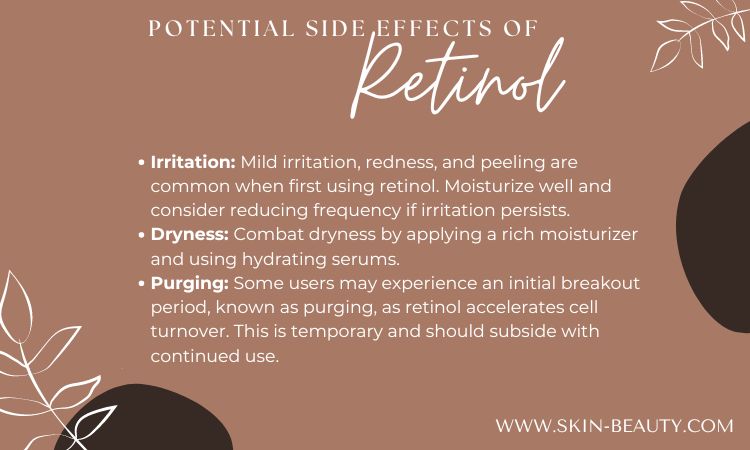How to Apply Retinol to Skincare Routine
How to Apply Retinol to Skincare Routine
Retinol is a form of vitamin A, a potent ingredient in skincare that offers many benefits for the skin. It can help reduce the appearance of fine lines, wrinkles, and hyperpigmentation while promoting cell turnover and collagen production, leading to a more youthful and radiant complexion. However, retinol can be potent and requires proper application to avoid irritation and maximize its benefits. When it comes to incorporating retinol into your skincare routine, it is essential to follow a step-by-step guide to ensure optimal results.
What is Retinol?
Retinol is a type of retinoid, a class of compounds derived from vitamin A. It promotes skin cell turnover and increases collagen production, making it a popular choice for addressing various skin concerns, including acne, fine lines, and uneven skin tone.
Benefits of Retinol
- Reduces Fine Lines and Wrinkles: By stimulating collagen production, retinol helps to minimize the appearance of fine lines and wrinkles.
- Improves Skin Texture: It promotes cell turnover, leading to smoother and more even skin texture.
- Fades Hyperpigmentation: Retinol can help fade dark spots and hyperpigmentation by accelerating the shedding of pigmented cells.
- Unclogs Pores: It helps to keep pores clear, reducing the likelihood of acne breakouts.
- Boosts Skin Radiance: Regular use can result in a more radiant and youthful complexion.

When and How to Use Retinol for Best Results?
Whether to use topical retinol in the morning or at night is a common question among skincare enthusiasts. It is generally recommended to apply retinol at night as it can make your skin more sensitive to sunlight. Incorporating retinol into your nighttime skincare routine allows the product to work its magic while you sleep.
How to Incorporate Retinol into Your Skin Care Routine
1. Choose the Right Retinol Product
- Strength: Beginners should start with a lower concentration of retinol (0.25% to 0.5%) to allow their skin to build tolerance. Higher concentrations (1% and above) can be introduced gradually.
- Formulation: Retinol comes in various forms, including creams, serums, and oils. Choose a formulation that suits your skin type and preferences.
2. Patch Test
- Why: A patch test is important to see how your skin reacts.
- How: Apply a small amount of retinol to a discreet area of your skin, such as behind your ear or forearm. Wait 24-48 hours to check for any irritation or allergic reaction signs.
3. Cleanse Your Face
- Step: Wash your face with a gentle cleanser and pat it dry. Ensure your skin is completely dry before applying retinol, as applying it to damp skin can increase irritation.
4. Apply Retinol
- Amount: Use a pea-sized amount of retinol for your entire face. More products do not equate to better results and can increase the risk of irritation.
- Method: Apply the retinol evenly across your face, avoiding sensitive areas such as the corners of your eyes, nostrils, and lips. Start from the center of your face and work outwards.
5. Follow with a Moisturizer
- Purpose: Moisturizing helps to minimize potential dryness and irritation caused by retinol.
- Method: After allowing the retinol to absorb for a few minutes, apply a gentle, hydrating moisturizer.
6. Gradually Increase Frequency
- Start Slow: If you’re new to retinol, start by applying it once or twice a week. Gradually increase the frequency to every other night and, eventually, to nightly use as your skin builds tolerance.
- Monitor: Pay attention to how your skin responds and adjust the frequency accordingly. If you experience significant irritation, reduce the frequency or switch to a lower concentration.
7. Use Sunscreen
- Importance: Retinol can increase your skin’s sensitivity to the sun, making it crucial to use broad-spectrum sunscreen with at least SPF 30 during the day.
- Daily Application: Apply sunscreen every morning, even on cloudy days, and reapply as needed.

Tips for Success
- Avoid Mixing: Avoid using other potent actives, such as AHAs, BHAs, and vitamin C, in the same routine as retinol serum, as this can increase irritation. Instead, use them on alternate nights.
- Stay Consistent: Consistency is key to seeing results with retinol. Incorporate it into your nightly routine and be patient, as it can take several weeks to notice improvements.
- Hydrate and Soothe: To support your skin barrier, incorporate hydrating and soothing products, such as hyaluronic acid and ceramides, into your routine.
Dealing with Side Effects and Choosing the Right Products
While retinol has numerous benefits, it can also have potential side effects, especially for sensitive skin. Some common side effects of using retinol include skin irritation, dryness, and increased sensitivity. Selecting the best retinol formula for your skin type is crucial to mitigate these effects.
Potential Side Effects of Retinol and How to Manage Them
- Irritation: Mild irritation, redness, and peeling are common when first using retinol. Moisturize well and consider reducing frequency if irritation persists.
- Dryness: Combat dryness by applying a rich moisturizer and using hydrating serums.
- Purging: Some users may experience an initial breakout period, known as purging, as retinol accelerates cell turnover. This is temporary and should subside with continued use.
When choosing a retinol product, consider factors such as your skin type, any existing skin concerns, and the concentration of retinol in the product. Opt for over-the-counter retinol products or consult a dermatologist for prescription-strength options catering to your needs.

Tips for Specific Skin Concerns When Using Retinol
For individuals with acne-prone skin, using retinol in your skincare routine can help unclog pores and reduce acne outbreaks. However, it is essential to introduce retinol gradually to avoid exacerbating skin issues. If you have sensitive skin, take precautions such as using a lower concentration of retinol and applying a soothing moisturizer to minimize irritation.
To make your skin less sensitive to retinol, start by using the product sparingly a few times a week and gradually increase frequency as your skin gets used to it. Consider incorporating other soothing skincare ingredients like niacinamide or hyaluronic acid to help alleviate any signs of skin irritation or redness.
Enhancing the Effects of Retinol with Additional Skincare
After applying retinol, following up with a moisturizer is essential to lock in moisture and prevent dryness. Retinol may cause temporary dryness or flakiness, so a hydrating moisturizer can help keep your skin supple and hydrated. If you experience dry skin due to retinol use, consider using a richer moisturizer or a facial oil to nourish your skin.
Retinol is a potent and effective ingredient that can transform your skincare routine by addressing multiple skin concerns. By starting with a lower concentration, gradually increasing frequency, and ensuring proper hydration and sun protection, you can reap the benefits of retinol while minimizing potential side effects. With patience and consistency, retinol can help you achieve smoother, clearer, and more youthful-looking skin.
Recent Posts
-
Best Face Wash for Sensitive Skin
My Journey to Finding the Best Face Wash for Sensitive Skin If you’re reading this, you probab …Apr 22nd 2025 -
Best Under-Eye Bags Cream and Treatment
Best Under-Eye Bags Cream and Treatment Do you have the dreaded under-eye bags that make you look l …Apr 14th 2025 -
Rice Water for Skin Benefits
Rice Water for Skin Benefits Rice water for skin has become a viral beauty trend that is supposed t …Apr 4th 2025




